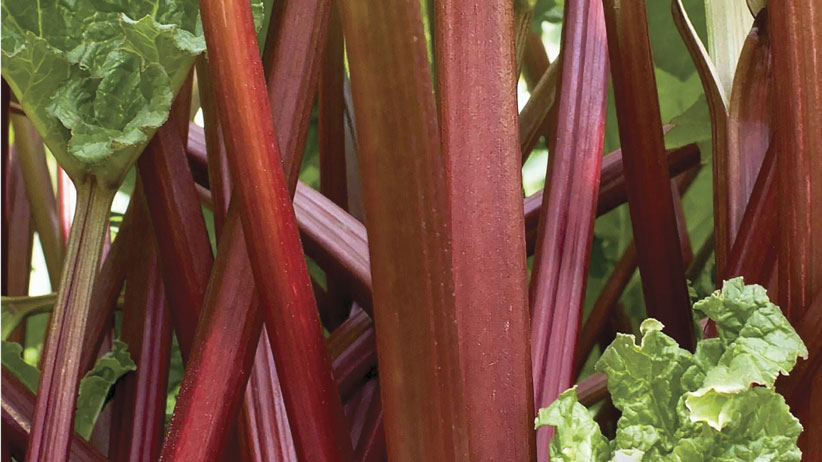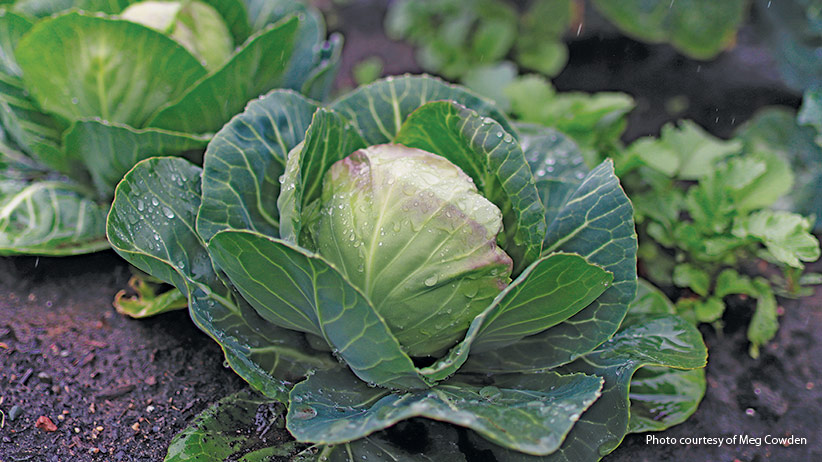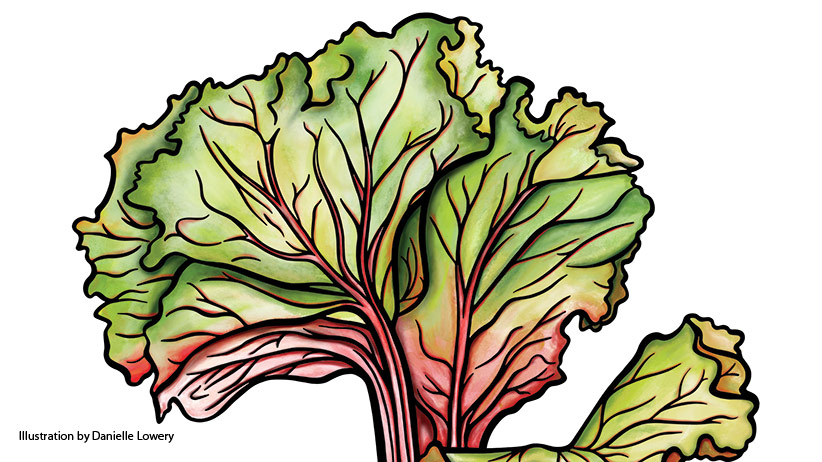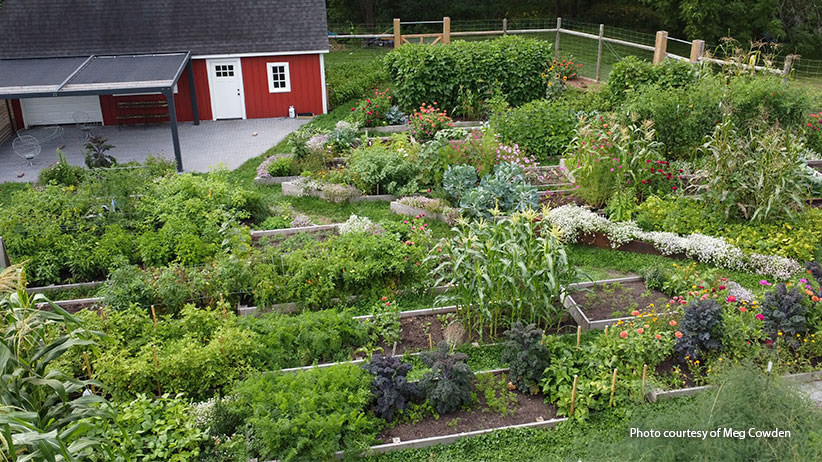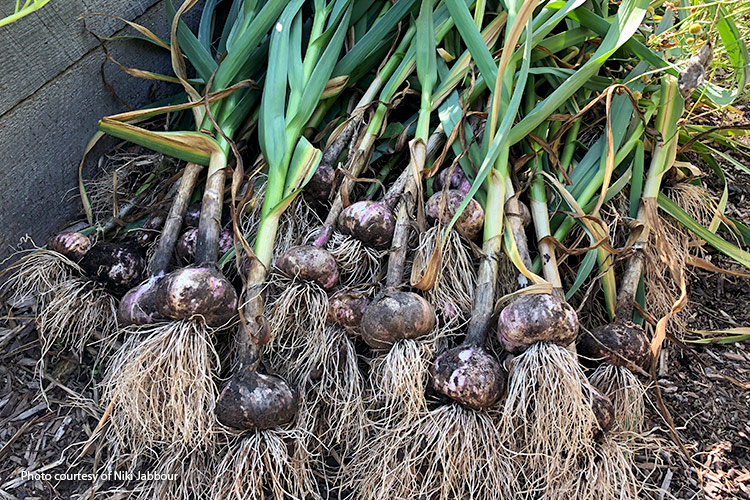
Grow your own garlic
There are many reasons to grow your own garlic. First, it’s really easy to do. I always tell new vegetable gardeners to include a patch of garlic. The plants are bothered by few pests and diseases; even the deer and rabbits that nibble on my other crops rarely venture into the garlic patch. It’s also extremely low maintenance, requiring little fussing during the growing season. The best reason to plant garlic, however, is flavor. Home grown cloves are packed with a depth of flavor that you’ll never find with supermarket varieties.
Fall is the best time to plant garlic
And while garlic cloves can technically be planted in early spring, autumn is the best time to plant if you want really big bulbs. I time my planting for about four to six weeks before the ground is expected to freeze (traditionally around Halloween). This gives the cloves time to set roots before the arrival of winter.
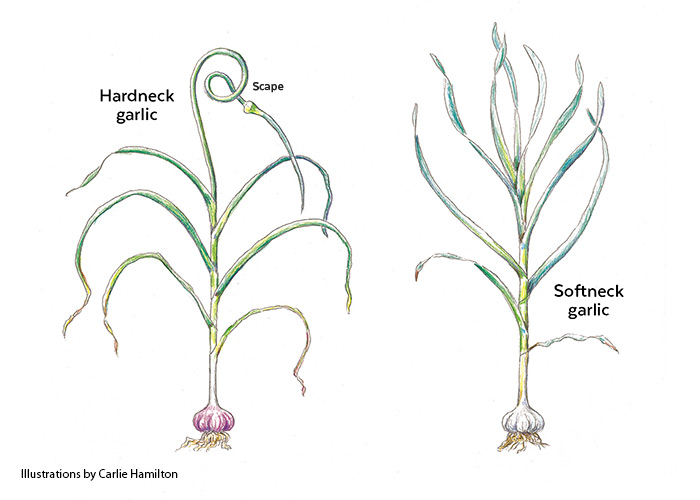
Hardneck & softneck garlic
Garlic can be grown almost anywhere in North America, from USDA zone 2 and warmer, although certain varieties do better in very cold regions. There are two main types of garlic: hardneck and softneck.
Hardneck garlic
This garlic produces a long flowering stalk, called a “scape,” in early summer. Beneath the soil, a single row of cloves develops around this central stalk. Hardneck garlic produces fewer cloves per bulb than softneck varieties, but each individual clove is larger, and many believe it to be more flavorful. Hardneck types are also usually more winter hardy than softneck garlic and are therefore the garlic of choice for short-season gardeners. Once harvested and cured, hardneck garlic stores for up to six months.
Softneck garlic
Softneck garlic is not usually as winter hardy as hardneck garlic and is often grown in milder regions. The bulbs are packed with cloves — sometimes more than 20 in a bulb! — that range in size from small to large. They do not produce a central scape, but instead have soft, flexible stems and leaves. This is why you’ll sometimes see softneck garlic braided for storage. And speaking of storage, softneck garlic stores very well, with the cloves remaining firm and flavorful for up to a year.
You Might Also Like:
How to Grow More Food in Less Space
7 Easy Plants to Grow from Seed
How to Start a Vegetable Garden
How to Plant Potatoes
Where to buy garlic for planting
There are three places I buy garlic for planting: my local garden center, the farmers market or an online catalog. Don’t buy garlic from the supermarket, as it may not be the right type for your climate and could also have been treated with a sprout inhibitor. If buying garlic locally, choose plump bulbs with no brown spots or mold. As long as bulbs were grown locally, any you buy at the farmers market will be fine in your garden. I’ve listed three good mail-order sources here, as well:
When choosing garlic to grow, don’t be shy about trying different varieties. There are hundreds of hardneck garlic varieties and dozens of softneck ones available to gardeners. While all taste like garlic, there are subtle flavor and pungency differences between types and varieties. I’ll highlight some later.
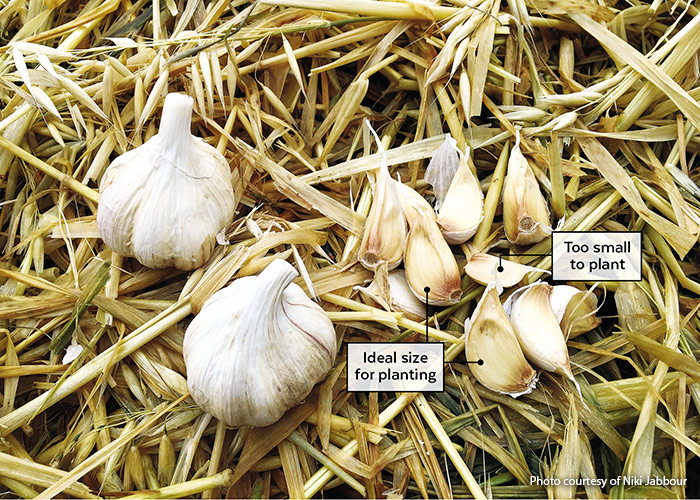
How to grow your own garlic
Garlic grows best in a site with at least six hours of sun each day. It also needs well-draining soil. Before planting, I loosen the soil and dig in 1 to 2 inches of compost or aged manure to improve the soil.
Once the garden is prepped, gently break the bulbs into individual cloves. You can see what they look like in the photo above. I separate varieties into different containers. Don’t plant naked cloves! Leave the papery covering intact when you plant as it protects the cloves from potentially damaging microbes.
Does clove size matter?
The smallest cloves won’t size up into large bulbs. I set these aside to be taken to the kitchen. I also take a close look at the largest cloves: Sometimes you can see that they’ve split in two within their papery husk. If planted, they’ll form two side-by-side plants and this can result in stunted bulbs. So I also toss large split cloves into the kitchen basket.
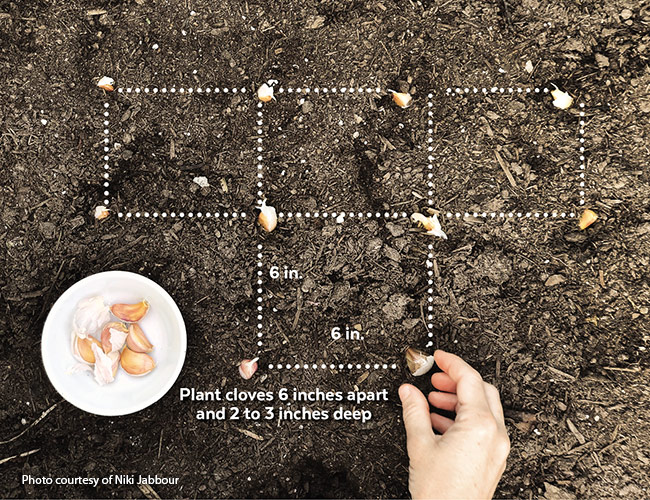
Planting garlic
I plant garlic in a grid pattern like you see in the photo above, spacing the cloves 6 inches apart and planting them 2 to 3 inches deep. After the bed has been planted, I water well and top dress with a slow-release organic bulb fertilizer. Then I mulch the soil with a 3-inch-deep layer of shredded leaves or straw. This reduces weed growth and insulates the bed for winter.
Seasonal garlic care
Feeding
As the weather warms in spring, you’ll notice green garlic shoots emerging from the mulch. At this point, I apply a balanced granular organic fertilizer. Garlic appreciates a steady supply of nutrients, and feeding the plants results in bigger bulbs. This initial feeding can be followed up with an application of a liquid organic fertilizer, such as fish emulsion, when the garlic scapes are removed (on hardneck types) in mid- to late spring.
Watering
If there has been no rain, I deep water the bed once a week with 1 to 2 inches of water. You can use a watering wand to hand water or snake a soaker hose through your garlic patch. While garlic growing problems are rare, keep an eye out for white rot, a fungal disease that affects onions and garlic. The first sign is yellowing leaves or stunted growth with the bulbs failing to develop well. Crop rotation and buying disease-free planting stock are the best way to avoid white rot.
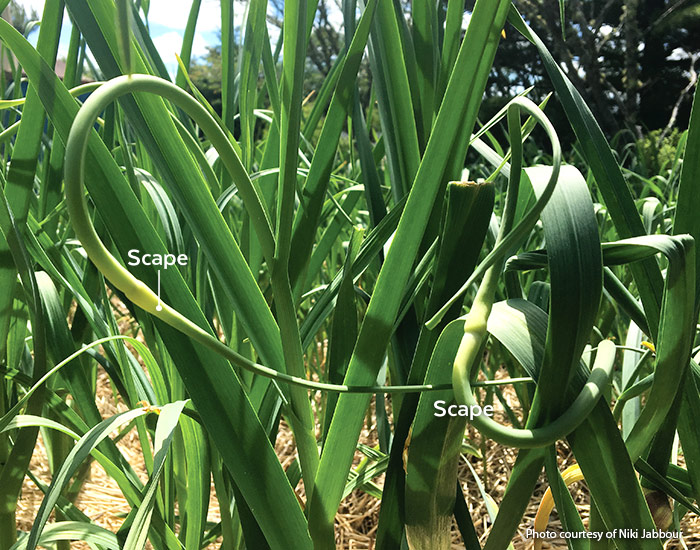
Garlic scapes
I grow hardneck garlic, which yields two crops: an early summer harvest of delicious scapes followed a month later by the bulbs. Depending on your region, the scapes emerge in mid-June to early July. They’re easy to spot as they look like a long, slender flower bud, which eventually curls into a spiral.
Harvesting garlic scapes
The photo above shows the best time to clip them with scissors or garden snips: as soon as they curl like a pig’s tail. If you wait until the scapes straighten out, they’ll be tough.
Research has shown that removing scapes results in bigger bulbs. That said, if you do accidentally leave a few on your plants you’ll notice that they are eventually topped with tiny cloves. You can sprinkle these on pastas, salads or other dishes for a yummy garlicky bite. The fresh scapes make a wonderful pesto or can be chopped and used like garlic in your cooking.

Harvesting & curing garlic
No matter if you’re growing softneck or hardneck garlic, it’s time to harvest when half of the leaves have yellowed. In the photo above I’m using a garden fork to loosen the soil and gently lift the bulbs. This reduced damage, which could shorten storage life. I brush off soil clumps clinging to the roots with my gloves.
How to cure home grown garlic
Before you store homegrown garlic, it needs to cure. Curing helps develop the flavor and prepare the bulbs for long-term storage. Here’s how to do it:
- Hang the plants, with the foliage still attached, in a room, shed or site that is out of direct sunlight, sheltered from rain, and well ventilated. A temperature in the range of 75 to 80 degrees F is ideal.
- If you have a laundry rack, use it to hang the bulbs. You can also lay them flat on a mesh screen or newspapers, flipping them over every day or two so they cure evenly for two weeks.
- After they’ve cured, clean the bulbs by trimming the leaves and roots. I leave a 2-inch stem and trim the roots to about 1 inch. I also remove the outer wrapper if it’s very dirty.
- Place the bulbs in a single layer in a box, basket or hang in mesh bags. Store garlic in a cool, well-ventilated room that is 60 to 65 degrees F. A dry basement is ideal, but you can also keep it in a pantry or storage room.
- If you don’t have a good spot to store garlic, you can freeze peeled cloves on a parchment-lined tray. Once they’re frozen, bag them up and store in the freezer.
Given its essential status in the kitchen, every garden needs a patch of garlic. It’s easy to grow, reliable and delicious. No space for a veggie garden? Tuck garlic cloves in ornamental beds, where the pungent aroma of the plants may even chase away insects and critters. Ready to give garlic a try? Check out the different types and varieties below.
You Might Also Like:
How to Grow Vegetables in Galvanized Raised Garden Beds
Cool-Season Vegetables to Plant in Fall
Straw Bale Gardening
Plant an Edible Landscape Around a Patio
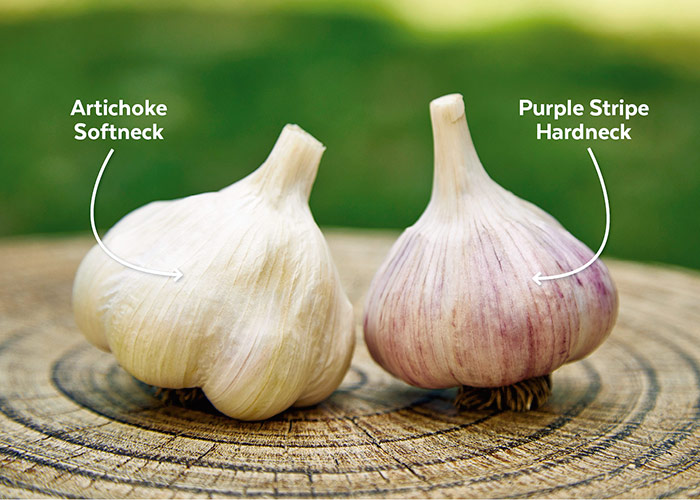
Different types of garlics to grow
Types of softneck garlic
Artichoke Named because the arrangement of cloves resembles the scales of an artichoke, the bulbs of this beautiful type of garlic are packed with layers of 10 to 14 cloves. These are long-storing garlics, holding quality for up to a year under ideal conditions. ‘Inchelium Red’ yields bulbs up to 3 inches across with a robust flavor.
Silverskin The longest-lasting garlics are the Silverskin varieties. They can store for over a year and grow well in a variety of conditions. They have white wrappers and 12 to 20 cloves per bulb. The flavor is typically strong and pungent. ‘Silver White’ and ‘Nootka Rose’ are two popular Silverskin varieties that are very productive.
Types of hardneck garlic
Purple Stripe
As the name suggests, the bulbs of Purple Stripe varieties have beautiful wrappers streaked in deep purple. I like to plant varieties like ‘Chesnok Red’, which yields eight to 10 narrow cloves per bulb. The flavor deepens and intensifies in storage. This is my favorite type of garlic to roast and smear on a fresh baguette.
Glazed Purple Stripe
These big bulbs contain eight to 10 cloves that are plump and covered with cream and purple wrappers. ‘Purple Glazer’ is a heritage variety with small but flavor-packed cloves.
Marbled Purple Stripe Like Purple Stripe varieties, the wrappers are beautiful and striped. This group offers fewer, but larger, cloves in each bulb. The intense garlic flavor has a bite when eaten raw. Varieties to try include ‘Kostyn’s Red Russian’ and ‘Purple Russian.’
Porcelain These garlics yield big bulbs with white wrappers and four to six large cloves per bulb. ‘Music’ is a popular variety known for its cold tolerance, high yield and deep, complex flavor.
Rocambole Rocambole garlics are widely grown for their excellent flavor (raw and cooked) and cold tolerance. Each bulb yields eight to 10 cloves. ‘Spanish Roja’ is perhaps the most popular Rocambole variety, and a must for any garlic lover.
What about elephant garlic?
When buying garlic you may also see packages of elephant garlic (Allium ampeloprasum ampeloprasum) for sale. The huge bulbs are hard to miss, but botanically, it’s not garlic. Elephant garlic is a member of the leek family, although the big bulbs do have a mild garlic flavor.









